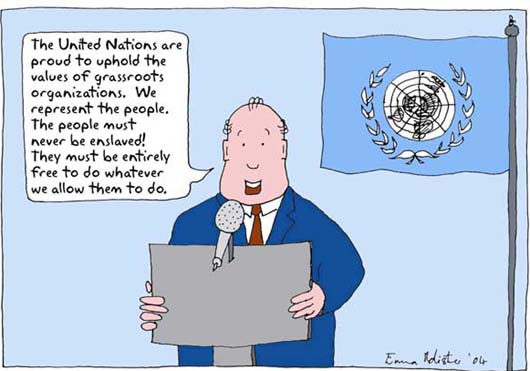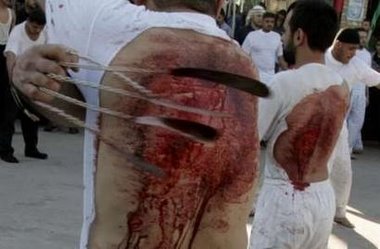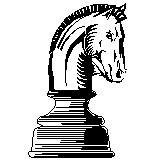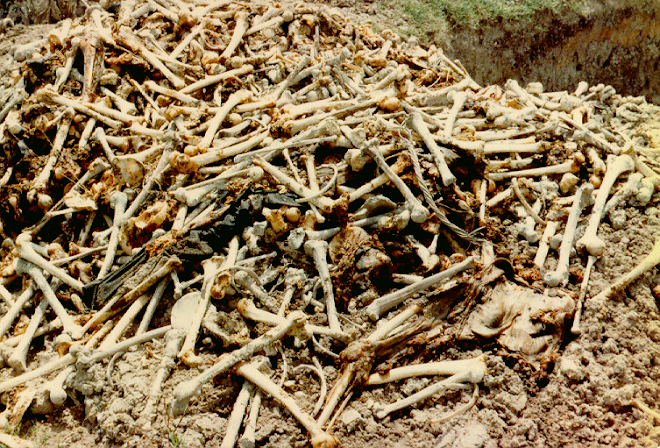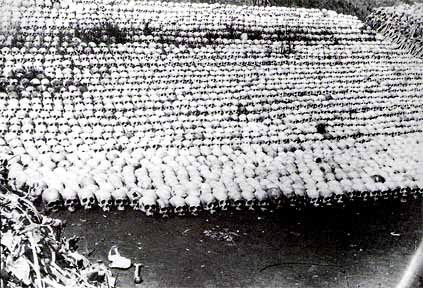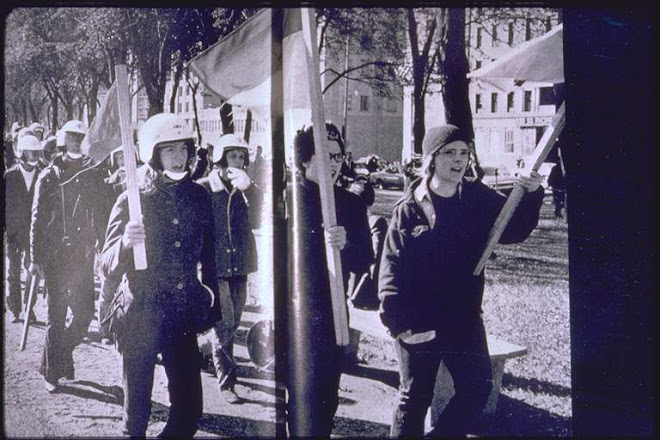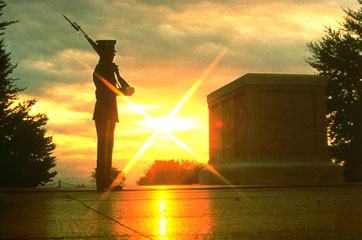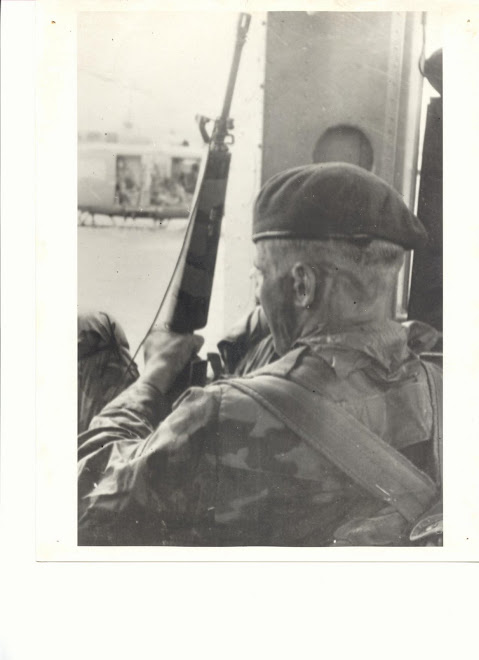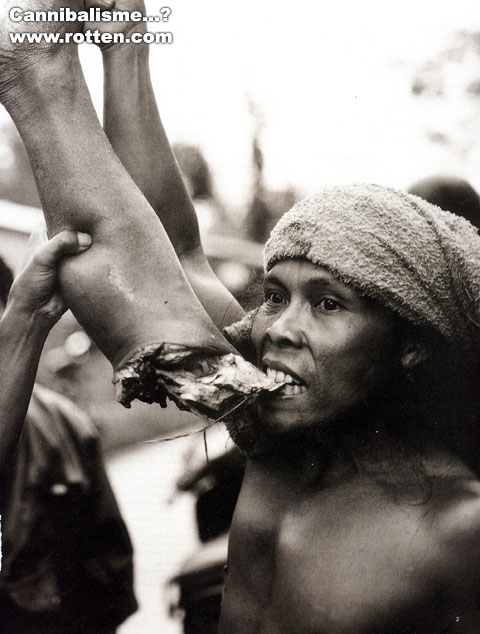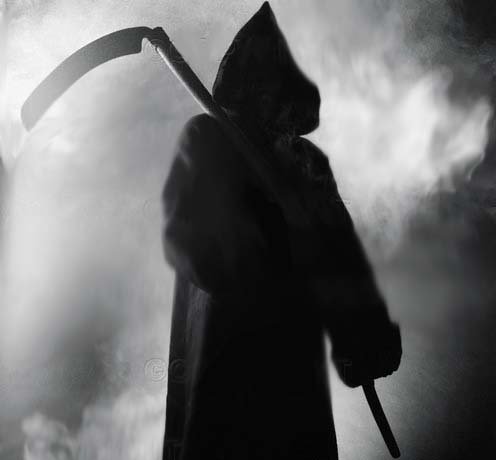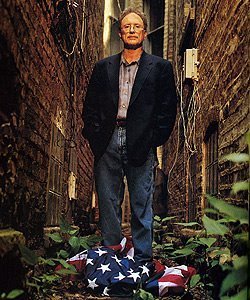The Nanuet Mall near Nyack, N. Y., is 20 miles north of Manhattan. On October 20, 1981, a Brink's armored-truck driver was waiting for guards to transfer bags of money from the Nanuet National Bank to the truck when a red van wheeled up and three men wearing ski masks jumped out firing automatic M-16 rifles, killing one guard and wounding a second.
A sawed-off shotgun was fired at the truck's driver, wounding him, while a black man who had been standing nearby began firing a pistol. The robbers grabbed six bags containing $1.6 million, leaped back into their van and rode off.
In the wake of the Nyack killings the picture of a revolutionary alliance between black, white and Puerto Rican insurgents emerged. This conspiracy had operated in secrecy for over five years. They committed bank robberies, freed their comrades from prison, and supported like minded fugitives as part of a larger network. ‘The movement,’ which had obvious international implications, had moved to open rebellion.
The Soviet Union, the Cuban government, the North Vietnamese Army, and other terrorist organizations such as the PLO were now operating a violent subculture in America.
Between 1972 and 1981 this terrorist movement had planted or set off more than 150 bombs, assassinated policemen, and killed or injured scores of American citizens.
As the Nyack investigation deepened, police found a ‘hit list’ that profiled dozens of American corporation executives and contained the biographies, photos and daily schedules of top New York and New Jersey police officials. Floor plans of police precinct stations and photographs of police barracks revealed plots for bombings and ambush murders like the one that occurred a decade earlier, in August of 1971, when a woman cased the Ingleside police station in San Francisco minutes before a Black Liberation Army gang walked in, killed the desk sergeant, wounded a female clerk but bungled the detonation of a mammoth bomb.
Using Canadian telephone numbers for some Weather fugitives, Cuban intelligence agents provided a communications link to the underground cells while other DGI agents instructed Puerto Rican terrorists already inside the United States. According to FBI records filed in court, a PLO agent had wired money to a Weather Underground founder suspected of constructing a bomb that damaged the U.S. Capitol in March 1971 (William Ayers).
As these terrorists conducted their campaign of kidnapping, armed robbery, assassination, and bombing inside the United States, the nation’s counter-terrorist intelligence apparatus was being dismantled. Civil-liberty lawsuits filed by radical lawyers who “explode the Law instead of bombs,” had vitiated or destroyed effective police intelligence units across the country.
Between Watergate and the completion in March 1976 of public hearings by the Church Committee of the U.S. Senate, three anti-subversive initiatives and a congressional committee were eliminated:
1. The Internal Security Division of the Department of Justice, originally established to support the FBI and other agencies with responsibilities in the area of internal security, was abolished at the direction of then Attorney General, Ed Levi.
2. The Subversive Activities Control Board, created by the Internal Security Act of 1950, was disbanded.
3. The responsibility of the Attorney General to maintain a list, made available to the public, of organizations determined to be Communist or totalitarian, was cancelled, again at the direction of then Attorney General, Ed Levi.
4. In the U.S. House of Representatives, the long-standing Committee on Internal Security, formerly known as the House Committee on Un-American Activities, was eliminated.
America was now completely vulnerable to the subversive elements that had won the above victories. The Levi Guidelines and Church committee reforms of 1976 are directly responsible for the inability of US counterintelligence services to fulfill its obligation to protect the American people, a fact supported by more than 30 years of ineffective counterterrorism that culminated in the 9-11 attacks against the WTC.
US Attorney General, Ed Levi, Appointed by President Gerald R. Ford
In 1976, US Attorney General, Ed Levi, an appointee of Republican president Gerald Ford, imposed a series of directives on police and intelligence services that impaired their ability to conduct domestic undercover operations against our enemies. The ‘Levi Guidelines’ wiped out many domestic surveillance operations and prosecution on those cases came to a standstill. After Ed Levi, intelligence-gathering in the conduct of domestic security investigations in America was no longer possible.
Levi prosecuted those FBI agents who were most successful in bringing domestic terrorists to justice. He indicted FBI acting director L. Patrick Gray, former Chief of Counterintelligence Edward Miller, and former acting associate director W. Mark Felt on charges of "conspiring to injure and oppress citizens of the United States." The "citizens" in question were members of the Weather Underground.
Eventually, 140 FBI agents were brought to trial for their efforts to apprehend Weather Underground terrorists. All of these agents were prosecuted for actions taken in 1972-73 under guidelines created by Levi in 1976 — a violation of the Constitution’s prohibition against ex post facto laws. This amounted to a judicial purge of the FBI’s counter-terrorism division.
Ed Levi was a ‘curious’ choice for Attorney General. He was a member of both the ACLU and the National Lawyer’s Guild.
“While the Guild is not officially communist or Marxist, its membership, leadership, past internal struggles, and adopted stances consistently point to an organization whose underlying convictions could best be described as such.” (FrontPageMagazine.com; Jesse Rigby; 25 April 2003.)
“The ‘Guild’ promoted "liberation" (i.e. Marxist) movements or groups overseas in the 1970s, including the Palestine Liberation Organization, the Viet Cong, the African National Congress, pro-Soviet Angolan and Mozambican factions, the Puerto Rican FALN, and the Philippine New People’s Army, "the military wing of the Communist Party of the Philippines."
In the years before the Nyack attack, the FBI's informants in political-terrorist groups had been cut from 1100 to fewer than 50. When a joint task force was set up to handle the Nyack case, the N.Y.P.D. and FBI were limited in their ability to move rapidly on the case – most of the old files were ordered destroyed to comply with ‘the Levi Guidelines.’
Showing posts with label KGB. Show all posts
Showing posts with label KGB. Show all posts
Sunday, November 23, 2008
International Terrorism and Domestic Enemies In the Streets, In the Courts, In the White House Inside Out:Infiltrated
Monday, November 17, 2008
Socialism, Communism, and Genocide
COMMUNISM AS DESTROYER
Communist Revolution and its totalitarian worship of the 'the Party' and demand for obediance or death is the greatest purveor of evil the world has known. In the early years of the Bolshevik revolution and consolodation of power in Russia, Hungary, Bulgaria, and the attempt to establish it in Spain in the 1930's, the true nature of collectivism is shown whether it is called socialism or communism or under whatever misnomer, it is evil that rules 'the party' and inspires a bloddletting without comparison.
Everywhere they make first for the clergy which has claim to the belief patterns of the target nation and the intellectuals who can challenge them with thought and reason, for reason and common sense must be suspended for anyone to desire an arbitratry authority over themselves and their nation.
Of all revolutionary systems, which throughout human history have been devised for the destruction of our civilized values, Communism is without doubt the most perfected, most efficient and most merciless.
In fact it represents the most advanced epoch of the world revolution, in whose postulates it therefore not only acts to destroy a definite political, social, economic or moral institution, but also simultaneously to declare null and void the Church as well as all cultural and Christian manifestations which represent our civilization.
All revolutionary currents have attacked Christianity in its different aspects with particular one-mindedness.
Communism, spawned from this same revolutionary stream of thought, seeks to banish Christianity for the purpose of causing it to vanish from the face of the earth, without even the slightest trace remaining.
The destructive fury of this satanic striving, which brings before the eyes of the world the most terrible pictures of terror and destruction which are possible to imagine, can only be based on the essence of Nihilism as the prelude to revolution, the most evil, hate-filled rejection of everything hitherto existing.
For otherwise, one would not be able to understand the indescribable insanity of its criminal acts and the spirit of destruction, of annihilation, of insult, of contradiction and of resistance by its leading personalities against everything free, and the fundamental features not only of Christianity but of religion in general.
The purpose of Communism, as we have seen in Russia and in the other lands where it has been introduced, is to enslave the people in their economic, political, social, and spiritual sense in order to make possible a minority rule through violence. From an international aspect, the goal cannot be clearer:
“To attain through violence world domination by an insignificant minority, which destroys the rest of humanity by means of materialism, terror and, if necessary, by death, completely indifferent to whether in the process the enormous majority of the population must be murdered.”
The urge to murder, which has characterised the leading Soviet personages and their satellites, is known well throughout the world. There are few, who upon learning of the bloody purges, which have been undertaken by the Marxists in Russia, will not be seized by shudders of horror. One needs only to recall a few details to fill the most stout hearts with fear and alarm.
“In its beginnings the Red Terror strove above all to exterminate the Russian Intelligentsia.” As proof of this assertion S.P. Melgunow affirms the following, in which he refers to the “Special Committees”, which appeared in Russia in the first period of the Social revolution and in similar form in every other revolutionized nation:
“The special committees are not organs of law, but of merciless extermination according to the decisions of the Communist Central Committee. The special committee is neither a commission of investigation nor a court of justice, but itself determines its own powers. It is an instrument of battle, which acts on the internal front of the civil war. It does not pardon whoever stands on the other side of the barricades, but kills them.
“It is not difficult to form ideas of how in reality this extermination proceeds, when in place of the nullified legal code only the revolutionary experience and conscience command. This conscience is subjective and experience allows complete free play to the will, which always, according to the position of the judge, takes on more or less furious forms.”
“Let us not carry on war against individual persons” – wrote Latsis – “but let us exterminate the Bourgeoisie as a class. Do not investigate, through study of documents and proofs, what the accused has done in words and deeds against the Soviet authority. The first question to be placed before him runs as to what class he belongs to, what is his origin, his education, his training and his profession.” This is exactly what befell the Cambodians after the Khmer Rouge came to poewer.
During the bloody dictatorship of Lenin, the Committee of Investigation under Rohrberg (Rohrberg, C.), which after the capture of Kiev entered this city with the White volunteers in August 1919, reported the following:
“The entire concrete floor of the large garage (this was the place where the provincial Cheka of Kiev had carried out executions) was swimming in blood, which did not flow but formed a layer of several inches; it was a grisly mixture of blood with brain and skull fragments, as well as strands of hair and other human remains. The entire walls, holed by thousands of bullets, were spattered with blood, and fragments of brain as well as head skin adhered to them.
“A drain ditch of 25 cm width and 25 cm deep and about 10 m long ran from the middle of the garage to a nearby room, where there was a subterranean outlet pipe. This drain ditch was filled to the top with blood.
“Usually, immediately after the massacre, the corpses were removed in lorries or horse-drawn wagons from the city and buried in a mass grave.
In the corner of a garden we came upon an older mass grave, which contained about 80 corpses, in which we discovered signs of the most varied and unimaginable cruelties and mutilation.
There were corpses from which the entrails had been removed; others had different limbs amputated and others again were cut into pieces. Some had had the eyes poked out, while the head, the face, the neck and the torso were covered with deep wounds. Further on we found a corpse with an axe in the breast, while others had no tongues. In a corner of the mass grave we discovered many legs and arms severed from the trunk.”
The enormous number of corpses, which have already been laid to the account of Communist Socialism and which increase terrifyingly all the while, will perhaps never be exactly known, but it exceeds everything imaginable. It is not possible to learn the exact number of the victims. All estimates lie below the real figure.”
In the Edinburgh newspaper “The Scotsman” of 7th November, 1923, Professor Sarolea gave the following figures in detailed description of how pervasive this evil machine was in carrying out its directive. You must ask yourselves, what kind of human being would carry out these crimes in such large scale?:
“28 Bishops; 1,219 priests; 6,000 Professors and teachers; 9,000 doctors; 54,000 Officers; 260,000 soldiers; 70,000 Policemen; 12,950 estate owners; 355,250 intellectuals and of the free professions; 193,290 tradesman and 215,000 peasants.”
The Information Committee of Denikin on the Bolshevistic intrigue during the years 1918-1919 records in a treatise about the Red Terror in these two years “one million, seven hundred thousand victims.” In the “Roul” of 3rd August 1923, Kommin makes the following observation:
“During the winter of 1920 there existed in the USSR, 52 governments with 52 Special Committees (Chekas), 52 Special Departments and 52 revolutionary courts. Besides countless subsidiary Chekas, transport-networks, courts on the railways as well as troops for internal security, there were mobile courts, which were dispatched to enforce mass executions in the places concerned.”
To this list of courts of torture must be added the special departments, i.e., 16 army and divisional courts. All in all one must there existed 1000's of torture chambers in which individual victims met deviates of the worst order. If it is borne in mind that at that time district committees also existed in addition, then the number rises further. In addition the number of governments of the USSR increased. Siberia, the Crimea and the Far East were conquered. The number of Chekas grew in geometrical ratio.
According to Soviet data (in the year 1920 when the terror had still not ebbed and the reporting of news was not restricted) it is possible to establish an average figure for every court; the curve of executions rises from one to fifty (in the great cities) and up to one hundred in the regions recently conquered by the Red Army.
The crisis of terror was periodic and then ceased; in this manner one can daily estimate the (modest) figure of five victims..., which, multiplied with the thousand courts, gives a result of five thousand, and thus for the year roughly one and a half million.
We recall this indescribable slaughter, not because in its totality it was either the most numerous or the most merciless to arise from the special situation and inflamed passions consequent on the first victories of the Bolshevist revolution, but because today, many years after these mass executions took place, all this might otherwise be obliterated from the present Communist picture, even for the persons who were contemporaries of the events and who today, if still alive, have forgotten those tragedies with the ease with which people forget not only unpleasant events which do not directly concern them, but even those to which they fell victim.
Unhappily, time has shown a truly demonic excess of Communism in its murderous activity. The monstrous statistics are known to all and several of these cruel bloodbaths have taken place recently and even continue in the conquered nations of Laos, Cambodia, and Viet Nam where the hill tribesman, Montagnard, and remnants of free Lao hide in the jungles, hunted like animals. One may hear today the lament of the persecuted, the death-rattle of the dying, and the terrible and haunting complaint of the corpses.
It may suffice to recall the giant bloodbaths in Hungary, Poland, East Germany and Cuba as well as the earlier mass killings by Stalin, the forced starvation of 5 million Ukranians, and the annihilation of millions of Chinese through the Communist regime of Mao-Tse-Tung and the millions more in the so called, 'Cultural Revolution' strewn with corpses.
But also the Communist attempts at revolution, which failed to achieve lasting permanence, such as that of Bela Kun who occupied Hungary in such a brutal way in the middle of 1919; of Spain in 1936, where the Bolsheviks gained control of Madrid and parts of the Spanish provinces and murdered 12 Bishops and more than 16,000 priests, monks and nuns; further the happily unsuccessful attempt in Germany, and in the Red Republic of Bavaria in the year 1919. All these attempts were orgies of torture and death in the manner of 1918 and which had bloodletting and unrestrained bestiality perpetrated on innocent victims.
This Apocalyptic storm, which brings a flood of corpses, blood and tears, and finally the peace of the cell, the shackle, and the grave falls upon the world with the sole goal: to destroy not only the Church but the entire Christian civilisation.
Before this shattering picture the world asks itself with heavy heart: who can hate our Christian features in such a form and try to destroy them with such Godless fury? Who has become capable of instigating this bloody mechanics of annihilation? Who can with such insensitivity direct and order this monstrous criminal process? And reality answers us completely without doubt that the [Bolshevik] are those responsible...
They now add to their rank of haters of all things Western and Christian, the Islamic Jihad. Together, with one goal, destruction of America, they need not be allies in the traditional sense.
Communist Revolution and its totalitarian worship of the 'the Party' and demand for obediance or death is the greatest purveor of evil the world has known. In the early years of the Bolshevik revolution and consolodation of power in Russia, Hungary, Bulgaria, and the attempt to establish it in Spain in the 1930's, the true nature of collectivism is shown whether it is called socialism or communism or under whatever misnomer, it is evil that rules 'the party' and inspires a bloddletting without comparison.
Everywhere they make first for the clergy which has claim to the belief patterns of the target nation and the intellectuals who can challenge them with thought and reason, for reason and common sense must be suspended for anyone to desire an arbitratry authority over themselves and their nation.
Of all revolutionary systems, which throughout human history have been devised for the destruction of our civilized values, Communism is without doubt the most perfected, most efficient and most merciless.
In fact it represents the most advanced epoch of the world revolution, in whose postulates it therefore not only acts to destroy a definite political, social, economic or moral institution, but also simultaneously to declare null and void the Church as well as all cultural and Christian manifestations which represent our civilization.
All revolutionary currents have attacked Christianity in its different aspects with particular one-mindedness.
Communism, spawned from this same revolutionary stream of thought, seeks to banish Christianity for the purpose of causing it to vanish from the face of the earth, without even the slightest trace remaining.
The destructive fury of this satanic striving, which brings before the eyes of the world the most terrible pictures of terror and destruction which are possible to imagine, can only be based on the essence of Nihilism as the prelude to revolution, the most evil, hate-filled rejection of everything hitherto existing.
For otherwise, one would not be able to understand the indescribable insanity of its criminal acts and the spirit of destruction, of annihilation, of insult, of contradiction and of resistance by its leading personalities against everything free, and the fundamental features not only of Christianity but of religion in general.
The purpose of Communism, as we have seen in Russia and in the other lands where it has been introduced, is to enslave the people in their economic, political, social, and spiritual sense in order to make possible a minority rule through violence. From an international aspect, the goal cannot be clearer:
“To attain through violence world domination by an insignificant minority, which destroys the rest of humanity by means of materialism, terror and, if necessary, by death, completely indifferent to whether in the process the enormous majority of the population must be murdered.”
The urge to murder, which has characterised the leading Soviet personages and their satellites, is known well throughout the world. There are few, who upon learning of the bloody purges, which have been undertaken by the Marxists in Russia, will not be seized by shudders of horror. One needs only to recall a few details to fill the most stout hearts with fear and alarm.
“In its beginnings the Red Terror strove above all to exterminate the Russian Intelligentsia.” As proof of this assertion S.P. Melgunow affirms the following, in which he refers to the “Special Committees”, which appeared in Russia in the first period of the Social revolution and in similar form in every other revolutionized nation:
“The special committees are not organs of law, but of merciless extermination according to the decisions of the Communist Central Committee. The special committee is neither a commission of investigation nor a court of justice, but itself determines its own powers. It is an instrument of battle, which acts on the internal front of the civil war. It does not pardon whoever stands on the other side of the barricades, but kills them.
“It is not difficult to form ideas of how in reality this extermination proceeds, when in place of the nullified legal code only the revolutionary experience and conscience command. This conscience is subjective and experience allows complete free play to the will, which always, according to the position of the judge, takes on more or less furious forms.”
“Let us not carry on war against individual persons” – wrote Latsis – “but let us exterminate the Bourgeoisie as a class. Do not investigate, through study of documents and proofs, what the accused has done in words and deeds against the Soviet authority. The first question to be placed before him runs as to what class he belongs to, what is his origin, his education, his training and his profession.” This is exactly what befell the Cambodians after the Khmer Rouge came to poewer.
During the bloody dictatorship of Lenin, the Committee of Investigation under Rohrberg (Rohrberg, C.), which after the capture of Kiev entered this city with the White volunteers in August 1919, reported the following:
“The entire concrete floor of the large garage (this was the place where the provincial Cheka of Kiev had carried out executions) was swimming in blood, which did not flow but formed a layer of several inches; it was a grisly mixture of blood with brain and skull fragments, as well as strands of hair and other human remains. The entire walls, holed by thousands of bullets, were spattered with blood, and fragments of brain as well as head skin adhered to them.
“A drain ditch of 25 cm width and 25 cm deep and about 10 m long ran from the middle of the garage to a nearby room, where there was a subterranean outlet pipe. This drain ditch was filled to the top with blood.
“Usually, immediately after the massacre, the corpses were removed in lorries or horse-drawn wagons from the city and buried in a mass grave.
In the corner of a garden we came upon an older mass grave, which contained about 80 corpses, in which we discovered signs of the most varied and unimaginable cruelties and mutilation.
There were corpses from which the entrails had been removed; others had different limbs amputated and others again were cut into pieces. Some had had the eyes poked out, while the head, the face, the neck and the torso were covered with deep wounds. Further on we found a corpse with an axe in the breast, while others had no tongues. In a corner of the mass grave we discovered many legs and arms severed from the trunk.”
The enormous number of corpses, which have already been laid to the account of Communist Socialism and which increase terrifyingly all the while, will perhaps never be exactly known, but it exceeds everything imaginable. It is not possible to learn the exact number of the victims. All estimates lie below the real figure.”
In the Edinburgh newspaper “The Scotsman” of 7th November, 1923, Professor Sarolea gave the following figures in detailed description of how pervasive this evil machine was in carrying out its directive. You must ask yourselves, what kind of human being would carry out these crimes in such large scale?:
“28 Bishops; 1,219 priests; 6,000 Professors and teachers; 9,000 doctors; 54,000 Officers; 260,000 soldiers; 70,000 Policemen; 12,950 estate owners; 355,250 intellectuals and of the free professions; 193,290 tradesman and 215,000 peasants.”
The Information Committee of Denikin on the Bolshevistic intrigue during the years 1918-1919 records in a treatise about the Red Terror in these two years “one million, seven hundred thousand victims.” In the “Roul” of 3rd August 1923, Kommin makes the following observation:
“During the winter of 1920 there existed in the USSR, 52 governments with 52 Special Committees (Chekas), 52 Special Departments and 52 revolutionary courts. Besides countless subsidiary Chekas, transport-networks, courts on the railways as well as troops for internal security, there were mobile courts, which were dispatched to enforce mass executions in the places concerned.”
To this list of courts of torture must be added the special departments, i.e., 16 army and divisional courts. All in all one must there existed 1000's of torture chambers in which individual victims met deviates of the worst order. If it is borne in mind that at that time district committees also existed in addition, then the number rises further. In addition the number of governments of the USSR increased. Siberia, the Crimea and the Far East were conquered. The number of Chekas grew in geometrical ratio.
According to Soviet data (in the year 1920 when the terror had still not ebbed and the reporting of news was not restricted) it is possible to establish an average figure for every court; the curve of executions rises from one to fifty (in the great cities) and up to one hundred in the regions recently conquered by the Red Army.
The crisis of terror was periodic and then ceased; in this manner one can daily estimate the (modest) figure of five victims..., which, multiplied with the thousand courts, gives a result of five thousand, and thus for the year roughly one and a half million.
We recall this indescribable slaughter, not because in its totality it was either the most numerous or the most merciless to arise from the special situation and inflamed passions consequent on the first victories of the Bolshevist revolution, but because today, many years after these mass executions took place, all this might otherwise be obliterated from the present Communist picture, even for the persons who were contemporaries of the events and who today, if still alive, have forgotten those tragedies with the ease with which people forget not only unpleasant events which do not directly concern them, but even those to which they fell victim.
Unhappily, time has shown a truly demonic excess of Communism in its murderous activity. The monstrous statistics are known to all and several of these cruel bloodbaths have taken place recently and even continue in the conquered nations of Laos, Cambodia, and Viet Nam where the hill tribesman, Montagnard, and remnants of free Lao hide in the jungles, hunted like animals. One may hear today the lament of the persecuted, the death-rattle of the dying, and the terrible and haunting complaint of the corpses.
It may suffice to recall the giant bloodbaths in Hungary, Poland, East Germany and Cuba as well as the earlier mass killings by Stalin, the forced starvation of 5 million Ukranians, and the annihilation of millions of Chinese through the Communist regime of Mao-Tse-Tung and the millions more in the so called, 'Cultural Revolution' strewn with corpses.
But also the Communist attempts at revolution, which failed to achieve lasting permanence, such as that of Bela Kun who occupied Hungary in such a brutal way in the middle of 1919; of Spain in 1936, where the Bolsheviks gained control of Madrid and parts of the Spanish provinces and murdered 12 Bishops and more than 16,000 priests, monks and nuns; further the happily unsuccessful attempt in Germany, and in the Red Republic of Bavaria in the year 1919. All these attempts were orgies of torture and death in the manner of 1918 and which had bloodletting and unrestrained bestiality perpetrated on innocent victims.
This Apocalyptic storm, which brings a flood of corpses, blood and tears, and finally the peace of the cell, the shackle, and the grave falls upon the world with the sole goal: to destroy not only the Church but the entire Christian civilisation.
Before this shattering picture the world asks itself with heavy heart: who can hate our Christian features in such a form and try to destroy them with such Godless fury? Who has become capable of instigating this bloody mechanics of annihilation? Who can with such insensitivity direct and order this monstrous criminal process? And reality answers us completely without doubt that the [Bolshevik] are those responsible...
They now add to their rank of haters of all things Western and Christian, the Islamic Jihad. Together, with one goal, destruction of America, they need not be allies in the traditional sense.
Monday, November 10, 2008
Soviet Spy, Lawyer, Government Official, Assassin's Council
John Abt
John Abt was the primary lawyer of choice by accused assassin Lee Harvey Oswald (President John F. Kennedy) and convicted assassin, Sirhan Sirhan (Robert F. Kennedy), yet neither accused assassin knew Jonathan Abt…
John Abt was an American Radical Lawyer, public official, Soviet Spy, and traitor.
He was the Chief of Litigation, Agricultural Adjustment Administration from 1933 to 1935, assistant general counsel of the Works Progress Administration in 1935, chief counsel on Senator Robert La Follette, Jr.'s, ‘LaFollette Committee’ from 1936 to 1937 and special assistant to the United States Attorney General, 1937 and 1938, in the administration of Franklin Delano Roosevelt. In 1948 Abt worked with the Progressive Party of former Vice President Henry A. Wallace.
Ware Group
Abt was also a member of the Ware group, a group of American governmental employees in the 1930s who belonged to the Communist Party of the United States. After the group's founder, Harold Ware, was killed in an automobile collision in 1935, Abt married Jessica Smith, Ware's widow.
In late 1943 Jacob Golos, who headed the Communist Party's secret apparatus, was referred to a group of party members by General Secretary of the Communist Party, Earl Browder.
This group of government employees had been engaged for some time in espionage for Browder, who held rank and position in the Soviet Union espionage apparatus, and held regular clandestine meetings at Abt's apartment.
In early 1944, Golos sent Elizabeth Bentley to make contact with the group at Abt's apartment. In attendance were John Abt, Victor Perlo, Charles Kramer, Harry Magdoff and Edward Fitzgerald.
They discussed paying party dues to Bentley, the various types of information each would be able to deliver, and the type of information other members not in attendance would also be willing to deliver.
In late 1943, the FBI opened an investigation of Abt. Its surveillance showed frequent meetings in the early months of 1944 between Abt and a man then known as Alexander Stevens, one of the several pseudonyms used by Josef Peters, who at one time headed the party's secret apparatus but was still involved in clandestine activities.
Abt turned the Perlo group over to the KGB in 1944.
Abt is referenced in Venona decrypts #588 KGB New York to Moscow, 29 April 1944 and #687 KGB New York tp Moscow, 13 May 1944.
During Lee Harvey Oswald's interrogation by the Dallas Police on the evening of 22 November 1963, after his arrest for the assassination of President John F. Kennedy, he requested the services of Mr. Abt:
"I want that attorney in New York, Mr. Abt. I don't know him personally but I know about a case that he handled some years ago, where he represented the people who had violated the Smith Act, [which made it illegal to teach or advocate the violent overthrow of the U.S. government] . . . I don't know him personally, but that is the attorney I want. . . . If I can't get him, then I may get the American Civil Liberties Union to send me an attorney."
Perlo group
The Perlo group is the name given to a group of people who provided information which was given to Soviet intelligence agencies; it was active during the World War II period, until the entire group was exposed to the FBI by the defection of Elizabeth Bentley.
It had sources on the War Production Board, the Senate La Follette Subcommittee on Civil Liberties; and in the United States Department of Treasury.
The Perlo group and Venona
Much useful addition information on the activities of the Perlo group was given by the Venona project. The first Venona transcript referencing the Perlo group gives the names of all the members in clear text, as code names had not yet been assigned (except in the case of Harold Glasser, who had already been assigned a code name because of previous engagements with Soviet espionage).
The Perlo group fits into the Venona project information when transcript # 687 of 13 May 1944 is examined.
Iskhak Akhmerov in New York City personally prepared a report to MGB headquarters in Moscow advising that some unspecified action had been taken regarding Elizabeth Bentley in accordance with instructions of Earl Browder. Akhmerov then made reference to winter and also to Harry Magdoff. This latter reference was then followed by a statement that in Bentley's opinion "they" are reliable. It was also mentioned that no one had interested himself in their possibilities.
The name Golovin was mentioned, and it was then reported that Victor Perlo, Charles Kramer, Edward Fitzgerald and Harry Magdoff would take turns coming to New York every two weeks. Akhmerov said Kramer and Fitzgerald knew Greg Silvermaster, whose cover name was later changed to "Robert".
Bentley advised that Jacob Golos informed her he had made contact with a group in Washington, D.C. through Earl Browder. After the death of Golos in 1943, two meetings were arranged with this group in 1944. The first meeting was arranged by Browder and was held in early 1944. The meetings were held in the apartment of John Abt in New York City and Bentley was introduced to four individuals identified as Victor Perlo, Charles Kramer, Harry Magdoff and Edward Fitzgerald.
KGB Archives
Allen Weinstein and Alexander Vassiliev in Haunted Wood, a book written from an examination of KGB Archives in Moscow, report the KGB credits the Perlo group members with having sent, among other items, the following 1945 U.S. Government documents to Moscow:
February
Contents of a War Production Board memo dealing with apportionment of aircraft to the USSR in the event of war on Japan:
WPB discussion of the production policy regarding war materials at an Executive Committee meeting.
Documents on future territorial planning for commodities in short supply.
Documents on a priority system for foreign orders for producing goods in the United States after the end of the war in Europe.
Documents on trade policy and trade controls after the war.
Documents on arms production in the United States in January 1945.
March
A WPB report on "Aluminum for the USSR and current political issues in the U.S. over aluminum supplies" (2/26/45);
April
Documents concerning the committee developing plans for the U.S. economy after the defeat of Germany.
Documents regarding war orders for the war against Japan.
Documents on the production of the B-29 bomber and the advanced B-32
Tactical characteristics of various U.S. bombers and fighters.
Materials on the United States using Saudi Arabian oil resources.
June
Data concerning U.S. war industry production in May from the WPB's secret report.
Data concerning plans for a 1945–1946 aircraft production from the WPB.
More data on specific aircraft's technical aspects.
August
Data concerning the new Export-Import Bank.
Data concerning supplies of American aircraft to the Allies in June 1945.
Data from the top secret WPB report on U.S. war industry production in June.
October
Detailed data concerning the industrial capacities of the Western occupation zones of Germany that could be brought out as reparations.
Information on views within the U.S. Army circles concerning the inevitability of war against the USSR as well as statements by an air force general supporting U.S. acquisition of advanced bases in Europe for the construction and deployment of missiles.
Perlo Group Members
Victor Perlo headed the Perlo group. Perlo was originally a member of the Ware group before World War II. The ring included a Senate staff director and supplied the Soviet Union with United States aircraft production figures.
Perlo infiltrated through the United States Department of Commerce in 1938 to gather data on basic economic decisions he presented to Harry Hopkins, Advisor to the President and Secretary of Commerce.
Perlo transferred to the Division of Monetary Research, and served under Harry Dexter White, followed by Frank Coe and Harold Glasser.
Perlo left the government in 1947.
Perlo also worked for the Brookings Institution and wrote a book critical of U.S. foreign policy, ‘American Imperialism.’
Perlo's code name in Soviet intelligence and in the Venona project is "Raider".
Victor Perlo was Chief of the Aviation Section of the War Production Board; head of branch in Research Section, Office of Price Administration Department of Commerce; Division of Monetary Research Department of Treasury; Brookings Institution
Edward Fitzgerald, War Production Board
Harold Glasser, Director, Division of Monetary Research, United States Department of the Treasury; United Nations Relief and Rehabilitation Administration; War Production Board; Advisor on North African Affairs Committee; United States Treasury Representative to the Allied High Commission in Italy
Alger Hiss, Director of the Office of Special Political Affairs United States Department of State
Charles Kramer, Senate Subcommittee on War Mobilization; Office of Price Administration; National Labor Relations Board; Senate Subcommittee on Wartime Health and Education; Agricultural Adjustment Administration; Senate Subcommittee on Civil Liberties; Senate Labor and Public Welfare Committee; Democratic National Committee
Sol Leshinsky, United Nations Relief and Rehabilitation Administration
Harry Magdoff, Statistical Division of War Production Board and Office of Emergency Management; Bureau of Research and Statistics, WTB; Tools Division, War Production Board; Bureau of Foreign and Domestic Commerce, United States Department of Commerce
George Perazich, Foreign Economic Administration; United Nations Relief and Rehabilitation Administration
Allen Rosenberg, Board of Economic Warfare; Chief of the Economic Institution Staff, Foreign Economic Administration; Senate Subcommittee on Civil Liberties; Senate Committee on Education and Labor; Railroad Retirement Board; Councel to the Secretary of the National Labor Relations Board
Donald Wheeler, Office of Strategic Services Research and Analysis division
These highly placed individuals were spying against America during the Stalin Era, long after the atrocities of Stalin, characterized by the Soviet Gulag and the brutality and excesses of Soviet totalitarianism were known in the west.
References:
Venona 588 New York to Moscow, 29 April 1944, pg.1. Perlo group
Venona 588 New York to Moscow, 29 April 1944, pg.2. Perlo group
Venona 588 New York to Moscow, 29 April 1944, pg.3. Perlo group
Venona 687 New York to Moscow, 13 May 1944. Perlo group
Venona 769, 771 KGB New York to Moscow, 30 May 1944, part 1
Venona 769, 771 KGB New York to Moscow, 30 May 1944, part 2
Venona 769, 771 KGB New York to Moscow, 30 May 1944, part 3
John Abt was the primary lawyer of choice by accused assassin Lee Harvey Oswald (President John F. Kennedy) and convicted assassin, Sirhan Sirhan (Robert F. Kennedy), yet neither accused assassin knew Jonathan Abt…
John Abt was an American Radical Lawyer, public official, Soviet Spy, and traitor.
He was the Chief of Litigation, Agricultural Adjustment Administration from 1933 to 1935, assistant general counsel of the Works Progress Administration in 1935, chief counsel on Senator Robert La Follette, Jr.'s, ‘LaFollette Committee’ from 1936 to 1937 and special assistant to the United States Attorney General, 1937 and 1938, in the administration of Franklin Delano Roosevelt. In 1948 Abt worked with the Progressive Party of former Vice President Henry A. Wallace.
Ware Group
Abt was also a member of the Ware group, a group of American governmental employees in the 1930s who belonged to the Communist Party of the United States. After the group's founder, Harold Ware, was killed in an automobile collision in 1935, Abt married Jessica Smith, Ware's widow.
In late 1943 Jacob Golos, who headed the Communist Party's secret apparatus, was referred to a group of party members by General Secretary of the Communist Party, Earl Browder.
This group of government employees had been engaged for some time in espionage for Browder, who held rank and position in the Soviet Union espionage apparatus, and held regular clandestine meetings at Abt's apartment.
In early 1944, Golos sent Elizabeth Bentley to make contact with the group at Abt's apartment. In attendance were John Abt, Victor Perlo, Charles Kramer, Harry Magdoff and Edward Fitzgerald.
They discussed paying party dues to Bentley, the various types of information each would be able to deliver, and the type of information other members not in attendance would also be willing to deliver.
In late 1943, the FBI opened an investigation of Abt. Its surveillance showed frequent meetings in the early months of 1944 between Abt and a man then known as Alexander Stevens, one of the several pseudonyms used by Josef Peters, who at one time headed the party's secret apparatus but was still involved in clandestine activities.
Abt turned the Perlo group over to the KGB in 1944.
Abt is referenced in Venona decrypts #588 KGB New York to Moscow, 29 April 1944 and #687 KGB New York tp Moscow, 13 May 1944.
During Lee Harvey Oswald's interrogation by the Dallas Police on the evening of 22 November 1963, after his arrest for the assassination of President John F. Kennedy, he requested the services of Mr. Abt:
"I want that attorney in New York, Mr. Abt. I don't know him personally but I know about a case that he handled some years ago, where he represented the people who had violated the Smith Act, [which made it illegal to teach or advocate the violent overthrow of the U.S. government] . . . I don't know him personally, but that is the attorney I want. . . . If I can't get him, then I may get the American Civil Liberties Union to send me an attorney."
Perlo group
The Perlo group is the name given to a group of people who provided information which was given to Soviet intelligence agencies; it was active during the World War II period, until the entire group was exposed to the FBI by the defection of Elizabeth Bentley.
It had sources on the War Production Board, the Senate La Follette Subcommittee on Civil Liberties; and in the United States Department of Treasury.
The Perlo group and Venona
Much useful addition information on the activities of the Perlo group was given by the Venona project. The first Venona transcript referencing the Perlo group gives the names of all the members in clear text, as code names had not yet been assigned (except in the case of Harold Glasser, who had already been assigned a code name because of previous engagements with Soviet espionage).
The Perlo group fits into the Venona project information when transcript # 687 of 13 May 1944 is examined.
Iskhak Akhmerov in New York City personally prepared a report to MGB headquarters in Moscow advising that some unspecified action had been taken regarding Elizabeth Bentley in accordance with instructions of Earl Browder. Akhmerov then made reference to winter and also to Harry Magdoff. This latter reference was then followed by a statement that in Bentley's opinion "they" are reliable. It was also mentioned that no one had interested himself in their possibilities.
The name Golovin was mentioned, and it was then reported that Victor Perlo, Charles Kramer, Edward Fitzgerald and Harry Magdoff would take turns coming to New York every two weeks. Akhmerov said Kramer and Fitzgerald knew Greg Silvermaster, whose cover name was later changed to "Robert".
Bentley advised that Jacob Golos informed her he had made contact with a group in Washington, D.C. through Earl Browder. After the death of Golos in 1943, two meetings were arranged with this group in 1944. The first meeting was arranged by Browder and was held in early 1944. The meetings were held in the apartment of John Abt in New York City and Bentley was introduced to four individuals identified as Victor Perlo, Charles Kramer, Harry Magdoff and Edward Fitzgerald.
KGB Archives
Allen Weinstein and Alexander Vassiliev in Haunted Wood, a book written from an examination of KGB Archives in Moscow, report the KGB credits the Perlo group members with having sent, among other items, the following 1945 U.S. Government documents to Moscow:
February
Contents of a War Production Board memo dealing with apportionment of aircraft to the USSR in the event of war on Japan:
WPB discussion of the production policy regarding war materials at an Executive Committee meeting.
Documents on future territorial planning for commodities in short supply.
Documents on a priority system for foreign orders for producing goods in the United States after the end of the war in Europe.
Documents on trade policy and trade controls after the war.
Documents on arms production in the United States in January 1945.
March
A WPB report on "Aluminum for the USSR and current political issues in the U.S. over aluminum supplies" (2/26/45);
April
Documents concerning the committee developing plans for the U.S. economy after the defeat of Germany.
Documents regarding war orders for the war against Japan.
Documents on the production of the B-29 bomber and the advanced B-32
Tactical characteristics of various U.S. bombers and fighters.
Materials on the United States using Saudi Arabian oil resources.
June
Data concerning U.S. war industry production in May from the WPB's secret report.
Data concerning plans for a 1945–1946 aircraft production from the WPB.
More data on specific aircraft's technical aspects.
August
Data concerning the new Export-Import Bank.
Data concerning supplies of American aircraft to the Allies in June 1945.
Data from the top secret WPB report on U.S. war industry production in June.
October
Detailed data concerning the industrial capacities of the Western occupation zones of Germany that could be brought out as reparations.
Information on views within the U.S. Army circles concerning the inevitability of war against the USSR as well as statements by an air force general supporting U.S. acquisition of advanced bases in Europe for the construction and deployment of missiles.
Perlo Group Members
Victor Perlo headed the Perlo group. Perlo was originally a member of the Ware group before World War II. The ring included a Senate staff director and supplied the Soviet Union with United States aircraft production figures.
Perlo infiltrated through the United States Department of Commerce in 1938 to gather data on basic economic decisions he presented to Harry Hopkins, Advisor to the President and Secretary of Commerce.
Perlo transferred to the Division of Monetary Research, and served under Harry Dexter White, followed by Frank Coe and Harold Glasser.
Perlo left the government in 1947.
Perlo also worked for the Brookings Institution and wrote a book critical of U.S. foreign policy, ‘American Imperialism.’
Perlo's code name in Soviet intelligence and in the Venona project is "Raider".
Victor Perlo was Chief of the Aviation Section of the War Production Board; head of branch in Research Section, Office of Price Administration Department of Commerce; Division of Monetary Research Department of Treasury; Brookings Institution
Edward Fitzgerald, War Production Board
Harold Glasser, Director, Division of Monetary Research, United States Department of the Treasury; United Nations Relief and Rehabilitation Administration; War Production Board; Advisor on North African Affairs Committee; United States Treasury Representative to the Allied High Commission in Italy
Alger Hiss, Director of the Office of Special Political Affairs United States Department of State
Charles Kramer, Senate Subcommittee on War Mobilization; Office of Price Administration; National Labor Relations Board; Senate Subcommittee on Wartime Health and Education; Agricultural Adjustment Administration; Senate Subcommittee on Civil Liberties; Senate Labor and Public Welfare Committee; Democratic National Committee
Sol Leshinsky, United Nations Relief and Rehabilitation Administration
Harry Magdoff, Statistical Division of War Production Board and Office of Emergency Management; Bureau of Research and Statistics, WTB; Tools Division, War Production Board; Bureau of Foreign and Domestic Commerce, United States Department of Commerce
George Perazich, Foreign Economic Administration; United Nations Relief and Rehabilitation Administration
Allen Rosenberg, Board of Economic Warfare; Chief of the Economic Institution Staff, Foreign Economic Administration; Senate Subcommittee on Civil Liberties; Senate Committee on Education and Labor; Railroad Retirement Board; Councel to the Secretary of the National Labor Relations Board
Donald Wheeler, Office of Strategic Services Research and Analysis division
These highly placed individuals were spying against America during the Stalin Era, long after the atrocities of Stalin, characterized by the Soviet Gulag and the brutality and excesses of Soviet totalitarianism were known in the west.
References:
Venona 588 New York to Moscow, 29 April 1944, pg.1. Perlo group
Venona 588 New York to Moscow, 29 April 1944, pg.2. Perlo group
Venona 588 New York to Moscow, 29 April 1944, pg.3. Perlo group
Venona 687 New York to Moscow, 13 May 1944. Perlo group
Venona 769, 771 KGB New York to Moscow, 30 May 1944, part 1
Venona 769, 771 KGB New York to Moscow, 30 May 1944, part 2
Venona 769, 771 KGB New York to Moscow, 30 May 1944, part 3
Labels:
Agent,
Assassin,
Cold War,
Espionage,
FDR,
John Abt,
KGB,
Lee Harvey Oswald,
New Deal,
Revolution,
Sirhan Sirhan,
Soviet Union,
Spy,
Subversion,
Treason,
Venona,
WW II
Friday, November 7, 2008
Russia Throws Down Hard, Challenge To Obama is Clear, His Ability Is Not
Stratfor Geopolitical Diary: Medvedev's Carefully Timed Address
www.stratfor.com
November 6, 2008
On Wednesday, as the entire world took in the idea of having Barack Obama as the next U.S. president, one of the greatest challengers to American power, Russia, decided to make itself immediately clear on its views of the current U.S. administration, Obama’s election and the global U.S. agenda.
Russian President Dmitri Medvedev gave his long-awaited first State of the State address (the equivalent of the U.S. president’s State of the Union address) on Nov. 5. The speech was much more than a nationalist appeal liberally sprinkled with Soviet-era rhetoric; it was a declaration of Russia’s return to the ranks of the world’s great powers. In effect, Medvedev not only tossed the gauntlet for Russia’s rivals in the West, but he also is not waiting around to see how they respond.
It must be understood that Medvedev — while he is certainly coming into his own under the sponsorship of his mentor, former president and current Prime Minister Vladimir Putin –- did not write this speech himself. The author is the Kremlin’s gray cardinal, Vladislav Surkov, who has played the role of backroom dealer, enforcer, planner and puppet master for Putin for most of the past eight years. Surkov does not control Putin — far from it -– but in many ways is the brains behind much of what happens in the Kremlin these days.
It was Surkov who recommended that Medvedev’s speech, originally scheduled for Oct. 23, be postponed. Ostensibly, the delay was meant to allow Russia more time to deal with its deepening financial crisis, but in reality, Surkov wanted to know which presidential candidate the Americans were going to elect. The speech was already written. In fact, according to Stratfor sources, two speeches had been written — one for each possible outcome of the U.S. election. In waiting for a clear picture on whom Moscow would be dealing with in Washington, Russia underscored the central role the United States plays in the international system, and that Moscow views Washington as its main counterweight.
Unlike many previous State of the State addresses, Medvedev’s Nov. 5 speech contained few veiled threats or simple proclamations. Instead, it announced hard actions, including the following statements:
Russia will deploy Iskander short-range ballistic missiles to Kaliningrad, a Russian enclave sandwiched between NATO and EU states Lithuania and Poland, in order to directly target the fledgling U.S. ballistic missile defense installations slated for Poland and the Czech Republic. (The Iskanders’ limited range will allow them to put only the Polish site at risk.)
Russia will return to a more Soviet-style system of term limits in order to more firmly entrench the power of the Putin team.
Moscow will not even consider negotiations with the lame-duck administration of President George W. Bush, preferring instead to wait for President-elect Barack Obama’s team, which Moscow thinks will be easier to manipulate (whether or not this proves true).
The United States is to blame not only for Russia’s war with Georgia, but also for the global financial crisis.
Russia will not make any concessions on its international position; the United States can take it or leave it.
All in all, these statements bear a degree of boldness that has long been present in Russian propaganda, though not necessarily backed up by any particular actions. Russia’s goal is simple: Use the three-month U.S. presidential transition period to impose a reality on the regions Moscow considers of core interest, presenting soon-to-be President Obama with a fait accompli. Most of Russia’s efforts will focus on Ukraine, but attention also will be spread throughout the Caucasus and Central Asia, as well as the Baltics, Belarus, Poland and the Czech Republic.
These states are already nervous about Obama’s ability to stand up to Russia’s new swagger, especially since he has never outlined a firm stance against Moscow and will be embroiled in other critical affairs, like Iraq and Iran. Now, Medvedev has told these states outright that Russia is about to act while the Americans can’t. He is playing on the states’ fears to push them into making a choice: Continue to depend on the United States (whether its support comes through or not), work with Moscow, or get crushed in the process.
Tell Stratfor What You Think
This report may be forwarded or republished on your website with attribution to www.stratfor.com
www.stratfor.com
November 6, 2008
On Wednesday, as the entire world took in the idea of having Barack Obama as the next U.S. president, one of the greatest challengers to American power, Russia, decided to make itself immediately clear on its views of the current U.S. administration, Obama’s election and the global U.S. agenda.
Russian President Dmitri Medvedev gave his long-awaited first State of the State address (the equivalent of the U.S. president’s State of the Union address) on Nov. 5. The speech was much more than a nationalist appeal liberally sprinkled with Soviet-era rhetoric; it was a declaration of Russia’s return to the ranks of the world’s great powers. In effect, Medvedev not only tossed the gauntlet for Russia’s rivals in the West, but he also is not waiting around to see how they respond.
It must be understood that Medvedev — while he is certainly coming into his own under the sponsorship of his mentor, former president and current Prime Minister Vladimir Putin –- did not write this speech himself. The author is the Kremlin’s gray cardinal, Vladislav Surkov, who has played the role of backroom dealer, enforcer, planner and puppet master for Putin for most of the past eight years. Surkov does not control Putin — far from it -– but in many ways is the brains behind much of what happens in the Kremlin these days.
It was Surkov who recommended that Medvedev’s speech, originally scheduled for Oct. 23, be postponed. Ostensibly, the delay was meant to allow Russia more time to deal with its deepening financial crisis, but in reality, Surkov wanted to know which presidential candidate the Americans were going to elect. The speech was already written. In fact, according to Stratfor sources, two speeches had been written — one for each possible outcome of the U.S. election. In waiting for a clear picture on whom Moscow would be dealing with in Washington, Russia underscored the central role the United States plays in the international system, and that Moscow views Washington as its main counterweight.
Unlike many previous State of the State addresses, Medvedev’s Nov. 5 speech contained few veiled threats or simple proclamations. Instead, it announced hard actions, including the following statements:
Russia will deploy Iskander short-range ballistic missiles to Kaliningrad, a Russian enclave sandwiched between NATO and EU states Lithuania and Poland, in order to directly target the fledgling U.S. ballistic missile defense installations slated for Poland and the Czech Republic. (The Iskanders’ limited range will allow them to put only the Polish site at risk.)
Russia will return to a more Soviet-style system of term limits in order to more firmly entrench the power of the Putin team.
Moscow will not even consider negotiations with the lame-duck administration of President George W. Bush, preferring instead to wait for President-elect Barack Obama’s team, which Moscow thinks will be easier to manipulate (whether or not this proves true).
The United States is to blame not only for Russia’s war with Georgia, but also for the global financial crisis.
Russia will not make any concessions on its international position; the United States can take it or leave it.
All in all, these statements bear a degree of boldness that has long been present in Russian propaganda, though not necessarily backed up by any particular actions. Russia’s goal is simple: Use the three-month U.S. presidential transition period to impose a reality on the regions Moscow considers of core interest, presenting soon-to-be President Obama with a fait accompli. Most of Russia’s efforts will focus on Ukraine, but attention also will be spread throughout the Caucasus and Central Asia, as well as the Baltics, Belarus, Poland and the Czech Republic.
These states are already nervous about Obama’s ability to stand up to Russia’s new swagger, especially since he has never outlined a firm stance against Moscow and will be embroiled in other critical affairs, like Iraq and Iran. Now, Medvedev has told these states outright that Russia is about to act while the Americans can’t. He is playing on the states’ fears to push them into making a choice: Continue to depend on the United States (whether its support comes through or not), work with Moscow, or get crushed in the process.
Tell Stratfor What You Think
This report may be forwarded or republished on your website with attribution to www.stratfor.com
Labels:
Appeasement,
Communism,
KGB,
Medvedev,
Missilles,
Nuclear War,
Nukes,
ObamaPutin,
Russia. Cold War,
Soviet Union
Subscribe to:
Posts (Atom)




